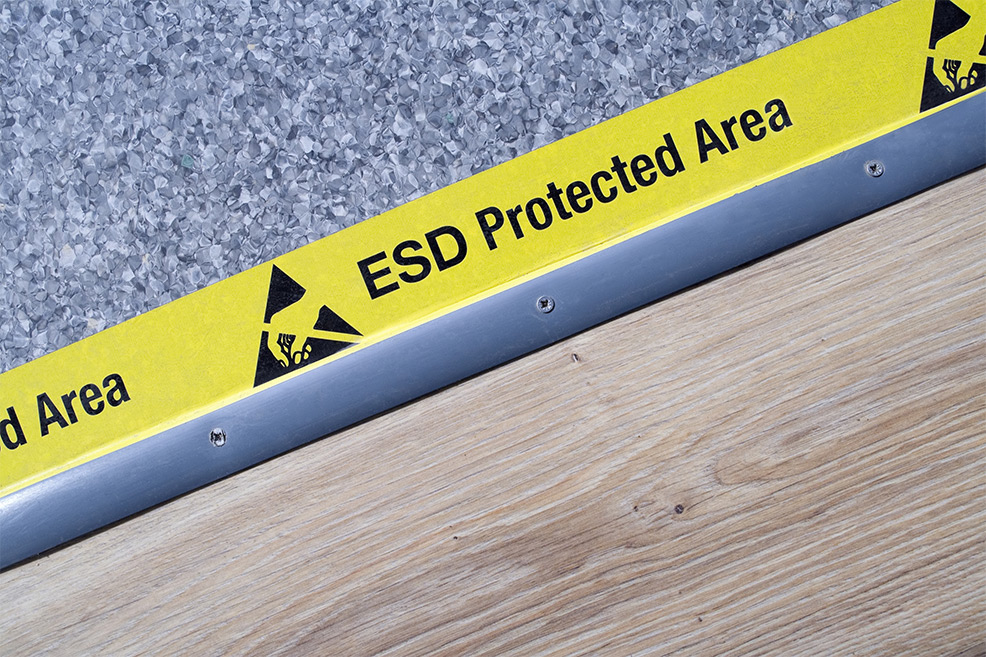Flooring / US / Do You Really Need Conductivity in Electrostatic Discharge Flooring?
5 minutes read
Do You Really Need Conductivity in Electrostatic Discharge Flooring?
Three Things to Understand about the ANSI/ESD Standard Specification
Electrostatic discharge (ESD) flooring specifiers often deal with a variety of standards and regulations, the most common and valuable of which is ANSI/ESD S20.20. However, the standard has inadvertently contributed to some confusion regarding the desired level of resistance for static dissipative floorings. The EOS/ESD Association, which developed the ANSI/ESD S20.20 standard, is currently considering a revision to the standard.
Specifying ESD control flooring resistance levels below 1 megohm is typically unnecessary to achieve ESD protection and mitigation. Resistance levels below 109 Ω can comply with the S20.20 standard if personnel walking voltage tests result in less than 100 volts on people.

Meeting the Demand for Anti-static Flooring
Demand for ESD flooring is continuing to grow beyond the traditional electronics manufacturing market. Call centers, data centers and even warehouses with autonomous vehicles now employ ESD paint to protect sensitive equipment. But the industry is facing challenges in meeting the demand for static dissipative coatings as some flooring installers have avoided the ESD market because of the complexity and the risk of hot spots.
The discussion on this page is specifically related to the use of epoxy coatings as an ESD control flooring material.
Below are three important points that every specifier should be clear about about S20.20 when specifying static dissipative flooring.

Fact #1
S20.20 Prescribes a Program, Not a Flooring Standard
The first misperception about S20.20 is that it establishes a standard for anti-static flooring specifications. It does that to a degree but only as part of a comprehensive ESD control program, which includes protective clothing, grounding systems, packaging, training and program management.
The stated purpose of the standard is to outline “the requirements necessary to design, establish, implement and maintain an Electrostatic Discharge (ESD) Control Program for activities that manufacture, process, assemble, install, package, label, service, test, inspect or otherwise handle electrical or electronic parts, assemblies and equipment susceptible to damage by electrostatic discharges greater than or equal to 100 volts Human Body Model (HBM).”
As such, the ultimate measure of success is not to achieve a certain resistance threshold across the floor but to prevent the accumulation of charge leading to a discharge of 100 volts or more from a person. Of course, the resistance to ground of the floor is essential to achieving this goal – it must be less than 109 Ω at all locations.

Fact #2
The Distinction Between Dissipative and Conductive Flooring is Irrelevant
Generally speaking, flooring that has resistance to ground of 105 to 109 Ω is considered dissipative rather than conductive flooring, while flooring with resistance less than 105 Ω is considered conductive. This has led to use of 1 megohm (106 Ω) as a convenient threshold for specifiers of ESD control flooring.
However, flooring in the 107 to 109 Ω range, when properly installed and supported by other program components, has been shown to meet the charge accumulation requirements of S20.20 while avoiding the risks of too much conductivity. The goal is to be on the low end of the static dissipative range and stay out of the static conductive range. The specification of a firm 1 megohm threshold is unnecessary and counterproductive.
“The current standards maintain the distinction between dissipative and conductive, which is not relevant in this application, and that may be contributing to confusion among specifiers,” said David Swenson, president of Affinity Static Control Consulting, LLC, and a director of the EOS/ESD Association. “This distinction will likely be eliminated in the next revisions of the applicable standards – anything under 109 will be considered conductive – to further address this issue. The most important characteristic is the resistance to ground of the person standing on the floor and their walking voltage.”

Fact #3
More Conductivity Isn’t Necessarily Better
Based on the current interpretation of the standard, 1 megohm is now widely specified as a resistance target by OEMs, architects and building owners. That isn’t an unreasonable approach, but it becomes problematic when one of two things happen.
Either 106 Ω is set as an absolute threshold and resistance above that level is considered unacceptable or specifiers conclude that if 106 Ω is good then 105 Ω must be even better. In the first case, it’s important to recognize that 106 is actually at the high end of the effective range of conductivity, and because resistance is logarithmic it can be difficult to hit a precise target. In addition, temperature and humidity variations across the floor, along with uneven dispersion of some conductive materials used in the ESD coat, create variations in resistance measurements. If resistance of 106 Ω is set as an absolute threshold, it’s likely that the actual overall floor resistance will be closer to 105 Ω – typically lower than necessary.
Rather than seeking to achieve the highest possible conductivity level, specifiers and building owners should be looking to reduce conductivity levels to the point where they can safely and consistently meet the S20.20 requirement of not discharging 100 volts. That level is resistance below 109 Ω.
How Can the Anti-static Agent Loading Rate Be Reduced Drastically?
Striving for unnecessarily low resistance levels complicates installation and the ability to control color and finish. Many epoxy flooring manufacturers use chopped or milled carbon fibers, tin oxide or metallic fibers to create the conductive network within the floor that transfers static electricity to ground. At resistance levels between 106 and 105, the loading rate, or percent of the flooring material that is composed of the additives, is generally in the 6% to 20% range.
At these high loading rates, the anti-static agent may overwhelm any color additives that are specified, typically resulting in a gray floor. Furthermore, it more difficult for the installer to achieve the smooth finish that most architects and building owners desire. The risk of an “orange peel” effect increases at higher loading rates.
Higher loading rates may also increase the risk of hot spots, where the carbon fibers or other anti-static additive aggregates in certain areas, breaking the conductive network and making the floor unable to transfer electricity to ground. Hot spots have become a persistent problem in the industry and can require the entire floor to be replaced.
Learn more about the specific strengths and limitations of anti-static agents from our article “Exploring 4 Types of Anti-static Agents for Conductive Flooring” or “Top Choice for an Anti-static Agent for Static Dissipative Flooring”
Explore the effect that conductive additives have on resistivity measurements and how the measured values affect the functionality of materials.